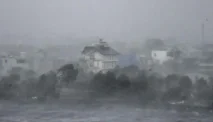Diksia.com - Rescue workers extricating trapped car occupants from a flooded tunnel in the South Korean city of Cheongju have found 13 bodies.
On Saturday night, the river burst its banks and flooded the tunnel, trapping people in cars and buses.
Officials did not disclose how many were trapped in the 685 m (2,500 ft) tunnel, but said there were 15 vehicles there.
Torrential rains have caused flooding, landslides and power outages across much of the country.
So far, at least 39 people have been reported dead as a result of heavy rains over the past week.
According to the authorities, at least nine people were still missing as of Monday morning due to the flooding.
Several bodies were recovered from the bus in the Osong suburb, where the tunnel was flooded. The nine people who were rescued on Saturday.
Relatives of the victims say the deaths might have been prevented if local authorities had responded effectively to the disaster.
Local media reported that the flood control agency had issued an alarming water level warning hours before the tragedy.
For this reason, traffic around the tunnel area had to be diverted.
Rapid flash flooding hit the road tunnel in Osong – near the city of Cheongju in central North Chungcheong Province – according to authorities. This did not give the drivers and passengers enough time to save themselves after the nearby river burst its banks.
Most of the other fatalities were reported from the mountainous region of North Gyeosang, where landslides had washed away entire homes.
About 300 mm (11.8 inches) of rain was reported across South Korea on Saturday.
According to the Korea Meteorological Agency, the country typically gets between 1,000 mm (39.4 in) and 1,800 mm (70.9 in) of rain a year — but most of that falls in the summer months.
Aerial photos of the flood-affected area show the brown mud and the flood water is so high that only the roofs of the houses can be seen.
Thousands of people were affected by this disaster and received evacuation orders from various local governments. Prime Minister Han Duck-soo has also ordered the military to help with the rescue effort.
About 6,400 residents were evacuated on Saturday morning local time after the Goesan Dam in north Chungcheong began to overflow.
Several lowland villages near the dam were inundated, as well as many of the roads connecting them. This left some residents trapped in their homes.
Also read:
On Friday, a landslide caused a train to derail in north Chungcheong. A technician was injured. The train was not carrying any passengers at this time.
South Korea’s national rail operator Korail has announced the suspension of all regular trains and some high-speed trains. The operator also said other express train services would be disrupted.
The Korea Meteorological Agency forecasts there will be more precipitation until next Wednesday. The agency warned that the weather conditions posed a “serious” hazard.
Extreme rains have caused flooding and landslides in several countries – including India, China and Japan – in the past two weeks.
Though many factors contribute to flooding, scientists say a warmer atmosphere is causing climate change. This makes extreme precipitation more likely.
The warmer it is, the more water vapor the atmosphere can hold, resulting in more water droplets and heavier precipitation. Sometimes in less time in a smaller area.






